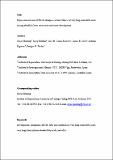Por favor, use este identificador para citar o enlazar a este item:
http://hdl.handle.net/10261/43400COMPARTIR / EXPORTAR:
 SHARE SHARE
 CORE
BASE CORE
BASE
|
|
| Visualizar otros formatos: MARC | Dublin Core | RDF | ORE | MODS | METS | DIDL | DATACITE | |

| Título: | Expression and role of Elovl4 elongases in biosynthesis of very long-chain fatty acids during zebrafish Danio rerio early embryonic development |
Autor: | Monroig, Óscar CSIC ORCID; Rotllant, Josep CSIC ORCID; Cerdá-Reverter, José Miguel CSIC ORCID CVN ; Dick, James R.; Figueras Huerta, Antonio CSIC ORCID ; Tocher, Douglas R. | Palabras clave: | Development Elongation Elovl4 Fatty acid metabolism Very long-chain fatty acids Very long-chain polyunsaturated fatty acids Zebrafish |
Fecha de publicación: | oct-2010 | Editor: | Elsevier | Citación: | Biochimica et Biophysica Acta Molecular and Cell Biology of Lipids 1801(10): 1145-1154 (2010) | Resumen: | Elovl4 is a fatty acyl elongase that participates in the biosynthesis of very long-chain fatty acids (≥C24), which are relatively abundant in skin (saturated chains), or retina, brain and testes (polyunsaturated chains) of mammals. In the present study we characterised two Elovl4 proteins, Elovl4a and Elovl4b, from zebrafish Danio rerio, and investigated their expression patterns during embryonic development. Heterologous expression in baker’s yeast showed that both zebrafish Elovl4 proteins efficiently elongated saturated fatty acids up to C36, with 26:0 appearing the preferred substrate as reported for human ELOVL4. Interestingly, activity for the elongation of PUFA substrates was only shown by Elovl4b, which effectively converted eicosapentaenoic (20:5n-3) and arachidonic (20:4n-6) acids to elongated polyenoic products up to C36. Furthermore, zebrafish Elovl4b may be involved in the biosynthesis of docosahexaenoic acid (22:6n-3, DHA) as it had the capacity to elongate 22:5n-3 to 24:5n-3 which can be subsequently desaturated and chain shortened to DHA in peroxisomes. The distinct functional roles of zebrafish Elovl4 proteins were also reflected in their spatial-temporal expression patterns during ontogeny. Analyses by whole-mount in situ hybridisation in zebrafish embryos showed that elovl4a was expressed in neuronal tissues (wide-spread distribution in the head area), with elovl4b specifically expressed in epiphysis (pineal gland) and photoreceptor cells in the retina. Similarly, tissue distribution in adults revealed that elovl4a transcripts were found in most tissues analysed, whereas elovl4b expression was essentially restricted to eye and gonads. Overall, the results suggest that zebrafish elovl4b resembles other mammalian orthologues in terms of function and expression patterns, whereas elovl4a may represent an alternative elongase not previously described in vertebrates. | Descripción: | 35 p., figuras y bibliografía | Versión del editor: | http://dx.doi.org/10.1016/j.bbalip.2010.06.005 | URI: | http://hdl.handle.net/10261/43400 | DOI: | 10.1016/j.bbalip.2010.06.005 | ISSN: | 1388-1981 |
| Aparece en las colecciones: | (IATS) Artículos (IIM) Artículos |
Ficheros en este ítem:
| Fichero | Descripción | Tamaño | Formato | |
|---|---|---|---|---|
| Monroig et al 2010 (accepted).pdf | 14,39 MB | Adobe PDF |  Visualizar/Abrir |
CORE Recommender
SCOPUSTM
Citations
104
checked on 01-abr-2024
WEB OF SCIENCETM
Citations
97
checked on 24-feb-2024
Page view(s)
389
checked on 22-abr-2024
Download(s)
308
checked on 22-abr-2024
Google ScholarTM
Check
Altmetric
Altmetric
NOTA: Los ítems de Digital.CSIC están protegidos por copyright, con todos los derechos reservados, a menos que se indique lo contrario.
